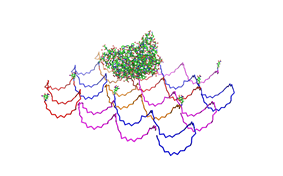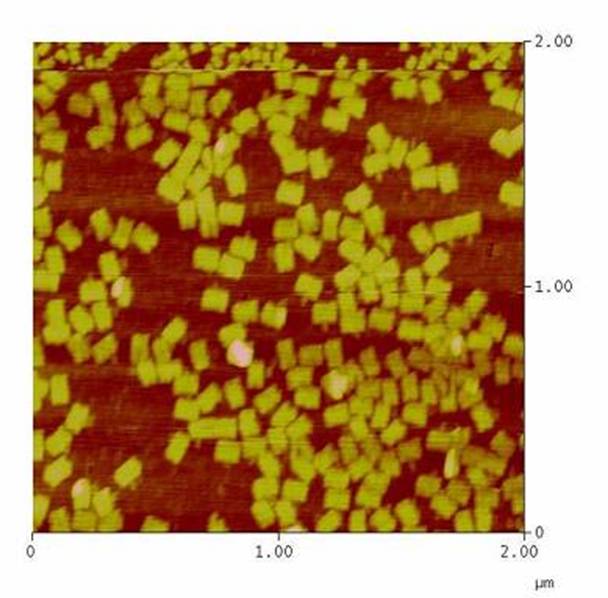DNA-Origami
From 2008.igem.org
(Difference between revisions)
| Line 88: | Line 88: | ||
fluorescence spectrometer, we had to increase the concentration of the | fluorescence spectrometer, we had to increase the concentration of the | ||
Origamis at least up to 200 nM. Because the oligos we had to use for | Origamis at least up to 200 nM. Because the oligos we had to use for | ||
| - | building the Origamis are very | + | building the Origamis are very expensive, we first tried to reduce the |
| - | ratio of Origami to oligos. | + | ratio of Origami to oligos. Therefore we tried to make Origamis with two |
(1:10) and four (1:5) times lower concentration of oligos. As positive | (1:10) and four (1:5) times lower concentration of oligos. As positive | ||
| - | control we took the 1:20 ratio at which we | + | control we took the 1:20 ratio at which we knew it should be stable. We |
used the AFM to check if the Origami are well formed. The results are | used the AFM to check if the Origami are well formed. The results are | ||
shown in figures 1-3. <br> | shown in figures 1-3. <br> | ||
| Line 99: | Line 99: | ||
[[Image:Team_Freiburg2008-Origami_1zu5.jpg|250 px]] | [[Image:Team_Freiburg2008-Origami_1zu5.jpg|250 px]] | ||
<br> | <br> | ||
| - | As we see in the figures 1-3 | + | As we see in the figures 1-3, all Origami are well formed. So we are |
able to use a 1:5 ratio to produce our Origami.<br> | able to use a 1:5 ratio to produce our Origami.<br> | ||
<h3>2. Origami in Krebs-Ringer-Hepes buffer</h3> | <h3>2. Origami in Krebs-Ringer-Hepes buffer</h3> | ||
| Line 106: | Line 106: | ||
to survive long enough to measure the calcium influx.<br> | to survive long enough to measure the calcium influx.<br> | ||
Beside that, the EDTA would disturb the calcium measurement. Hence we | Beside that, the EDTA would disturb the calcium measurement. Hence we | ||
| - | + | had to find a different buffer in which the Origami and the T | |
cells are stable and which can also be used for the calcium | cells are stable and which can also be used for the calcium | ||
measurement. In literature we found, that many people use a so-called | measurement. In literature we found, that many people use a so-called | ||
Krebs-Ringer-HEPES buffer for calcium measurement in LSRII fluorescence | Krebs-Ringer-HEPES buffer for calcium measurement in LSRII fluorescence | ||
spectrometer. We used 1:20 and 1:5 ratio of DNA to oligo to | spectrometer. We used 1:20 and 1:5 ratio of DNA to oligo to | ||
| - | make the | + | make the Origami. Each of the ratios was buffered in Krebs-ringer-HEPES |
buffer. As positive control we used Origami buffered in TAE/MgAc. The | buffer. As positive control we used Origami buffered in TAE/MgAc. The | ||
results are shown in figure 4 and 5.<br> | results are shown in figure 4 and 5.<br> | ||
| Line 121: | Line 121: | ||
formed Origami. Some bigger structures in Krebs-Ringer-HEPES buffer in | formed Origami. Some bigger structures in Krebs-Ringer-HEPES buffer in | ||
figure 4 seem to be parts of the Origami. Maybe the Origami did form | figure 4 seem to be parts of the Origami. Maybe the Origami did form | ||
| - | right in the MasterCycler, but then | + | right in the MasterCycler, but then fell apart when we buffered them in |
the Krebs-Ringer-HEPES buffer. Because we read in literature that some | the Krebs-Ringer-HEPES buffer. Because we read in literature that some | ||
salts in the Krebs-Ringer-HEPES buffer could disturb the interaction of | salts in the Krebs-Ringer-HEPES buffer could disturb the interaction of | ||
| Line 129: | Line 129: | ||
factor in the Krebs-Ringer-HEPES buffer could be the lack of magnesium | factor in the Krebs-Ringer-HEPES buffer could be the lack of magnesium | ||
or the calcium. Therefore we first tested if the Origami are stable in | or the calcium. Therefore we first tested if the Origami are stable in | ||
| - | Origami in Krebs-Ringer-Hepes buffer with 12. | + | Origami in Krebs-Ringer-Hepes buffer with 12.5 mM magnesium. Still we |
didn´t see any Origami (data not shown). <br> | didn´t see any Origami (data not shown). <br> | ||
<br> | <br> | ||
| Line 136: | Line 136: | ||
magnesium is much bigger, which could lead to deformed and instable | magnesium is much bigger, which could lead to deformed and instable | ||
Origami. Therefore it could be also tested if the Origami are stable in | Origami. Therefore it could be also tested if the Origami are stable in | ||
| - | Krebs-Ringer-HEPES buffer with 12. | + | Krebs-Ringer-HEPES buffer with 12.5 mM magnesium, but without calcium. |
Because the buffer has also to be suitable for the cells, the stability | Because the buffer has also to be suitable for the cells, the stability | ||
of the Origami in phosphate buffer without calcium should be tested.<br> | of the Origami in phosphate buffer without calcium should be tested.<br> | ||
Revision as of 22:19, 29 October 2008
 "
"







